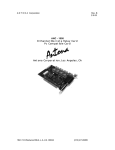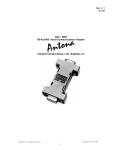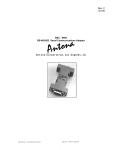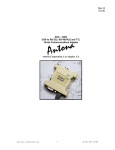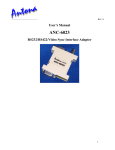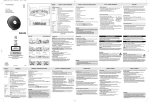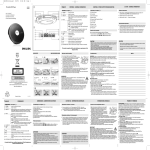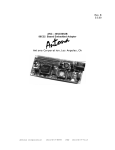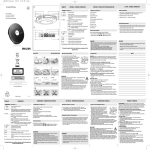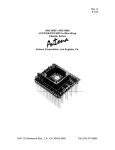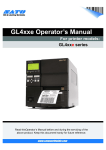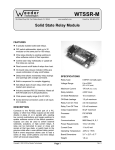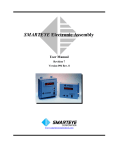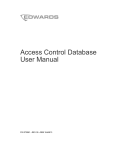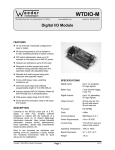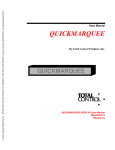Download PDF formatted ANC-6185 User`s Manual
Transcript
Rev. C $ 5.00 ANC - 6185 RS-485/422 Serial Communications Adapter Antona Corporation, Los Angeles, CA ANC-6185T Antona Corporation i ANC6185R (818)783-4299 Antona Corporation Copyright Copyright (c) 2003-2015 by Antona Corporation. All rights reserved. No part of this publication may be reproduced, transmitted, transcribed, stored in a retrieval system, or translated into any language or computer language, in any form or by any means, electronic, mechanical, magnetic, optical, chemical, manual or otherwise, without the prior written permission of the Antona Corporation of Los Angeles, California. Warranty Antona Corporation products are warranted to be free from defects in materials and workmanship for a period of one (1) year from the date of original shipment to customer. This warranty is limited to the replacement or repair of parts not subjected to misuse, neglect, unauthorized repair, alteration (except card options), accident, or failure due to the effects of static electricity discharge. In no event shall Antona Corporation be liable to the purchaser for loss of use, profit, or consequential damages, or damages of any kind, including, but not limited to, accidental loss or damage to other equipment, arising out of use of Antona Corporation equipment, whether or not said equipment was used properly. The designer is responsible for the determining the suitability and use of the product. This warranty is in lieu of any other warranty, expressed, implied, or statutory, including, without limitation, any implied warranty or merchantability or fitness for a particular purpose. No amendment of this warranty may be effected except in writing by an officer of the Antona Corporation. All repair services shall be performed at the Antona Corporation plant in Los Angeles, Ca. THE PURCHASER MUST OBTAIN A RETURN AUTHORIZATION FROM THE ANTONA CORPORATION PRIOR TO RETURNING ANY PIECE OF EQUIPMENT. Shipment to the Antona Corporation will be at the expense of the purchaser, return shipment will be at the expense of the Antona Corporation for all warranty repairs. Antona Corporation 1 (818)783-4299 TABLE OF CONTENTS FEATURES ...................................................................................................................................................................................3 OVERVIEW ..................................................................................................................................................................................3 MECHANICAL SPECIFICATIONS ....................................................................................................................................................3 ELECTRICAL SPECIFICATIONS ......................................................................................................................................................3 ADAPTER INSTALLATION .............................................................................................................................................................4 SERIAL PORT POWERING ..............................................................................................................................................................4 EXTERNAL POWERING .................................................................................................................................................................4 ADAPTER JUMPER OPTIONS.................................................................................................................................................5 Figure 1 - ANC-6185 jumper locations ................................................................................................................................................... 5 TRANSMIT CONTROL ENABLE - JP1 .............................................................................................................................................5 AUTO TRANSMIT SOURCE - JP2 ...................................................................................................................................................5 Photo 1 – Auto Transmit Operation......................................................................................................................................................... 6 figure 2 – RTS low to Tx enable ............................................................................................................................................................. 6 RECEIVE ENABLE - JP3 ................................................................................................................................................................6 CABLE TERMINATION - JP4..........................................................................................................................................................6 Figure 3 – terminating resister jumpering................................................................................................................................................ 7 TX - RX PIN REVERSE JUMPERS – JP5/JP6 ...................................................................................................................................7 figure 4 – Tx/Rc Pin Reverse Jumpers .................................................................................................................................................... 7 DCD DRIVE – JP7........................................................................................................................................................................8 2 –WIRE / 4 – WIRE INTERFACE – JP8/JP9 ...................................................................................................................................8 Figure 5 – 2/4 wire interfacing ................................................................................................................................................................ 8 LED INDICATOR ENABLE – JP10 .................................................................................................................................................8 ANC-6185 EXTERNAL RS-232 CONNECTIONS ...................................................................................................................8 DB9 TO DB25 PIN TO PIN CHART - FOR USE OF ADAPTER ON A DB25 TYPE COM PORT .................................................................9 RS-485/422 CONNECTIONS TO THE ANC-6185 ...................................................................................................................9 MASTER RS-485/422 SIGNALS (AS SHIPPED) ...............................................................................................................................9 SERVER (RECEIVE FROM MASTER)...............................................................................................................................................9 INTERFACE WIRING ...................................................................................................................................................................10 Terminal Block Wiring – T adapter version..........................................................................................................................10 RJ-45 Wiring – R adapter version ........................................................................................................................................10 RS-485 TWO AND FOUR WIRE INTERFACING ................................................................................................................10 2-WIRE .......................................................................................................................................................................................10 Photo 2 – 2-wire interface example ....................................................................................................................................................... 11 4-WIRE ......................................................................................................................................................................................11 APPENDIX A – ANC-6185 TROUBLESHOOTING GUIDE................................................................................................12 Loopback Test .......................................................................................................................................................................12 CABLING (most common type problem) ..............................................................................................................................12 Pin Signal Definition (4-wire interfaces) ..............................................................................................................................12 Multidrop Cabling (2-wire interfaces) ..................................................................................................................................12 Data Direction Jumpers........................................................................................................................................................13 Signal Control Jumpers.........................................................................................................................................................13 Cable Termination ................................................................................................................................................................13 Powering ...............................................................................................................................................................................13 Program Operation...............................................................................................................................................................14 RS422/485 Equipment...........................................................................................................................................................14 Now What?............................................................................................................................................................................14 APPENDIX B – TRANSMIT / RECEIVE LEDS ....................................................................................................................15 APPENDIX C -CIRCUIT BOARD SCHEMATIC .................................................................................................................16 Antona Corporation 2 (818)783-4299 Features ♦ ♦ ♦ ♦ ♦ ♦ ♦ ♦ ♦ ♦ ♦ ♦ ♦ ♦ ♦ Meets or beats EIA-232 to EIA-485 and EIA-422 Specifications (with external power) Easy interface with discrete wires or low cost Ethernet type cabling Transmit data at distances up to 4,000 feet (1,219.2 m) Baud rates to 1 Mbaud (tested to 1.2Mbps) Powered from serial port for most installations 4 wire full duplex or 2 wire half duplex operation Operate in multidrop / multipoint applications (RS-485) Selectable data loopback feature or data echo suppression (in 2-wire applications) Choice of fixed, auto or RTS high controlled transmit and receive Auto-transmit (AutoXmit) enable is available at baud rates up to 64 KBPS. Latest surface mount technology (SMT) for low power and small size RoHS Compliant – Lead Free parts and construction Jumperable terminate (120 ohms) on input Plug compatible with RS-232 PC serial port DB-9 connector Optional LED transmit and receive status indicators (ANC-6185TL or RL) Overview The ANC-6185 adapter converts the serial port RS-232 level transmit and receive signals on an IBM compatible personal computer (PC), or any device with an RS-232 type interface, into a differential noise immune RS-485 or RS-422 compatible signal. The adapter interface voltage levels produced meet the EIA-232, TIA-232, RS-485 and RS-485/422 signals. These adapters find wide use in high-speed long distance serial communications, multidropped 2-wire interfaces or to interface a PC with equipment that uses an RS-485 or RS-485/422 type input/output. The adapter is powered by the host system’s signal lines the same way a serial port “mouse” interface is powered. For most installations this eliminates the need for an external power supply making the adapters an ideal choice for portable use. Extended cable runs and/or terminated RS-485/422 connections may require more current than the serial port power can provide so the RS-485/422 connector can accept +3v to +12v regulated DC at 100 milliamps to provide the added power to drive the adapter. Mechanical Specifications Adapter case size: ANC-6185T = 2.9" X 1.3", ANC-6185R = 3.0” X 1.3” Connectors: female DB9 to PC RS-232 serial port ANC-6185T = 6-pin terminal block to RS485/422 ANC-6185R = RJ-45 modular connector to RS485/422 Electrical Specifications Power requirements= 7 ma for short cable, non-terminated applications 100 ma for long and/or terminated cable applications External Voltage = +3v to +12v DC at 100 ma minimum RS-485/422 output drive= short proof output, non-terminated operation to 150 feet, terminated operation with external power supply to 4,000 feet. RS232 output drive=short proof output, under worse case conditions, ±5v switching to exceed ±3v EIA RS232 specification Antona Corporation 3 (818)783-4299 Adapter Installation Turn off the personal computer and any other remote equipment before performing the adapter installation. Never install or remove the adapter with the power applied to the PC or any of the attached equipment. This could result in permanent damage to the adapter due to static discharge. Normally the adapter is plugged directly into the serial port male DB-9 jack on the back of the PC. The user should screw the 2 mounting screws into the serial port’s hex nuts for permanent installations to assure good long-term connection. The adapter may be attached to a ribbon cable type extension from the PC to the Antona adapter. This is sometimes useful when the space is limited behind the PC. The ribbon cable extension should not exceed 3 feet. A 12’ shielded wire cable could also be used. Remember that the signal is still RS-232C level leaving the computer and entering the adapter. Also note that if the designer is using a DB9 to DB25 adapter an A-B selector box or break-out box for testing, that all 9 pins should be connected through the adapter or test setup. The main ANC6185 adapter power is drawn from the host system’s RTS and DTR lines, like a serial comport mouse interface. Serial Port Powering Three of the PC’s serial port RS-232C level signals can be used by the Antona adapter to derive power from: RTS, DTR and TX. The user must therefore insure that the RTS and DTR signals from the PC’s serial port are brought to a high output level 100 ms before communicating over the adapter. Usually this is performed once during the user’s program initialization. If desired, with the appropriate jumper settings, RTS is lowered and raised to receive and transmit respectively. In this mode, DTR must be left high to power the adapter when RTS is set low. The adapter can be powered down by lowering RTS and DTR when standby current usage is an issue (to conserve battery power for example). External Powering An external +3 to +12 Voltage source may be feed into pin 1 (marked ‘V’ on the board) , and the power supply Ground connected to pin 6 (marked ‘G’ on the PCB), on the ANC-6185T terminal block version. See the right hand side of figure 1 below for the terminal block pinouts. Power is wired to pin 4 on the and ground to pin 5 on the RJ-45 connector of the ANC-6185R version. The table “RS-485/422 Connections to the ANC-6185” shows the pinouts for using an external source of DC to power either adapter version. There are also two pads on the ANC-6185 circuit board you can solder leads to for applying external power. A small hole in the plastic case would need to be added to run the power supply leads away from the adapter. This may be useful in applications by using 2 spare wires to send power to a remote adapter. An example would be where one externally powered ANC-6185 connected to a PC inside of an office sends power with the data signals to a roof mounted RS485 serial temperature reading monitor. Figure 1 below shows the pads as black dots. The regulated +DC source is soldered to the pin located just to the right of JP7, and the power supply ground pin is soldered to the pad just above JP4. Antona Corporation 4 (818)783-4299 Adapter Jumper Options gnd +V Figure 1 - ANC-6185 jumper locations When shipped, the ANC-6185 is set for transmit (JP1) and receive (JP3) enabled always. The output pins are set for ‘master’ (JP5/6), the terminating resister (JP4) is disconnected , RTS is connected to DCD (JP7) and 4-wire interfacing is set (JP8/9). Jumper 10 (JP10) is used to enable powering of the optional Tx Rc LED indicators. All references to ‘horizontal’ and ‘vertical’ below are in respect to figure 1 above. The schematic on the last page of this manual, gives another view of each jumper showing the settings on isolated block drawings of each jumper function. To open the enclosure hood use a small flat blade screwdriver and carefully pry the plastic latches on one side of the enclosure and gently separate the sides slightly (about .020”). Place a paper clip or coin between the separated sides of the enclosure to keep it from relatching shut while you repeat the process on the two plastic latches on the other side of the hood. The two sides of the hood should now come apart. The computer side mounting screws are loose within the enclosure so be careful of these small parts. Best to leave the enclosure off the adapter while jumper changes are made and tested in operation. To reassemble the enclosure hood back around the adapter electronics, place the circuit board into the enclosure half that designates signal direction with the RS-485/422 end (terminal block / RJ-45) on the arrowhead end pointed to by the small “RS485/422” designation. Now place the small screws back into position on the RS232, or computer side, DB-9. Transmit Control Enable - JP1 For single adapter 4-wire setups where the ANC-6185 is controlling one piece of equipment, JP1 can be set in the horizontal position (as shipped) so that the transmit data RS485/422 driver lines are always asserted. For battery powered applications, it may be desirable to turn off the transmit drivers to save current when there is no data being transmitted. When using either the transmit data control or RTS signal control to automatically control driver output, the vertical position MUST be set and JP2 (below) should be set for the desired transmit control condition. See Appendix B, the middle left hand of the schematic for the location of JP1. Auto Transmit Source - JP2 The designer can automatically turn on the RS-485/422 transmit driver lines by using either the transmitted data itself (JP2 set to the vertical position) or the RTS line (as shipped, JP2 set to the horizontal position). See Appendix B, the lower left hand of the schematic for the location of JP2. As shipped the ANC-6185 is set for one character time at 9600 baud, or about 1 millisecond. When the TX RS-232C data line starts to transmit by toggling a logic ‘high’ on the serial port producing the raising edge of the ‘start’ bit, circuitry on the ANC-6185 will detect and turn on the transmit RS-485/422. The photo below shows how a RS-232 character being transmitted (top trace) triggers the transmit driver enable line (lower trace) to perform the auto Antona Corporation 5 (818)783-4299 transmit (AutoXmit) function. There are actually two 9600 baud characters superimposed to show how the transmit enable line always allows about 1ms from the falling edge of the last bit. Photo 1 – Auto Transmit Operation RTS may also be used to turn on/off the transmit driver lines. Normally when RTS is used, asserting the signal ‘high’ to the adapter enables transmitting. This makes sense because more current is used from the RTS line during transmit in self powered applications. If your application software requires RTS to be low on transmit, you can use a wire jumper either wire-wrapped to the top side of the circuit board or a short piece of wire soldered to the bottom side of the circuit board to select RTS enable transmit ‘low’ and set RS-485/422 drive output as pictured in figure 2 below. Note that DTR must be set high when RTS is low in order for the adapter to operate when an external power supply is not being used. figure 2 – RTS low to Tx enable Receive Enable - JP3 This 3-pin straight vertical jumper can be set to enable receiving RS-485/422 data always (as shipped, JP3 set on the lower and middle pin), or turned off automatically whenever the transmit driver is active which is set by JP1 and JP2 above (JP3 set on the middle and upper pin. See Appendix B, the middle left hand of the schematic for the location of JP3. On a 2-wire interface if data is being transmitted and the receiver is also enabled, anything transmitted will be ‘looped-back’ into the serial port. Since the echoed signal is the actual data that was transferred to the interface cable, being able to see the transmitted data echoed back may be of use for testing, authenticating or diagnostics of data output. Cable Termination - JP4 Antona Corporation 6 (818)783-4299 For site lengths greater than 150 feet, resister termination across the remote receive pair end of the cable may be necessary. The ANC-6185 has a ½W 120 ohm termination resister built in that can be placed across the receive wire pair by setting jumper 4 (JP4) located over the transmit/receive setting jumpers (JP5/6). An external DC power source may be necessary to supply the additional current that the adapter may need when terminating resisters are installed on the receive/transmit wire pairs. Some equipment have internally connected circuitry for 120 ohm resister termination. If So, then even if the separation distance is less than 150 feet, it may be necessary to provide an external source of DC. Often equipment also allows the user to disconnect the internal termination network for short cable runs. See Appendix B, the upper middle of the schematic for the location of JP4. Figure 3 – terminating resister jumpering Tx - Rx Pin Reverse Jumpers – JP5/JP6 These two jumper sets, designated JP5 and JP6 on the ANC-6185 circuit board and schematic, allow the designer to swap the transmit and receive pairs on the RS-485/422 side of the adapter. The configuration as shipped from Antona is set for ‘master’. Figure 1 shows the jumper locations on ANC-6185 circuit board and figure 4 below shows the jumper settings. The user can move all four jumpers on the card from the horizontal ‘master’ (controller) configuration to the vertical ‘server’ (remote) configuration. All four jumpers must be changed to either all horizontal or all vertical for proper adapter operation as shown in figure 4 below, and on the schematic of Appendix B. For normal interfacing, use the jumpering of JP5/6 as shipped. For other interfaces, the user hand-wires a cable assembly from the RS-485/422 piece of equipment to the Antona adapter using either discrete wires (T version) or a male RJ-45 (R version). The only difference between the master and server setting is the jumper positions of JP5 and JP6 within the adapter. The electronics are exactly the same, only the 2 transmit and 2 receive signal lines are exchanged on the RS-485/422 side of the adapter. This feature is probably most useful on the ‘R’ RJ-45 version adapter where a pre-made ethernet compatible cable may be used. On the ‘T’ terminal block version, the designer just wires to the appropriate terminal figure 4 – Tx/Rc Pin Reverse Jumpers block pin per the signal function and changing the jumpers for opposite ends of the cable is not needed. Antona Corporation 7 (818)783-4299 DCD Drive – JP7 This 2-pin jumper disconnects the DCD serial port input line from the RTS signal output. When not jumpered a small amount of current is saved by not holding the DCD line high when RTS is high. RTS is one of the two main power sources for the adapter. This jumper is enabled when shipped by a short trace between the two jumper pads on the solder side of the PCB. If the designer wishes to disconnect the RTS to DCD connection, just use an Exacto knife to cut and remove the small trace between the two pads of JP7. Reconnection may be performed by soldering in a small wire through the two pad holes of JP7. See Appendix B, the upper middle of the schematic for the location of JP7. 2 –Wire / 4 – Wire Interface – JP8/JP9 These two 2-pin jumpers connect the TX lines to the RC lines for configuring the ANC6185 for 2-wire multidrop interfacing. The jumpers are disabled when shipped for use with separate transmit and receive wire pairs typical in 4-wire interfaces. Figure 5 – 2/4 wire interfacing LED Indicator Enable – JP10 If the optional LED transmit and receive indicators have been installed, JP10 may be used to enable or disable their operation. Shipped enabled if the option was ordered. Many times after the interface is installed and working, the LED indicators are not needed and some applications, a source of illumination within the work room or factory floor is not desired. See Appendix B for more details on the LED circuit operation. ANC-6185 External RS-232 connections Signal DCD/RLS D RX TX DTR Function Data Carrier Detect GND DSR RTS GROUND Data Set Ready Ready to Send CTS RI Clear to Send Ring Indicator RECEIVE DATA TRANSMIT DATA Data Term Ready Antona Corporation DB-9 Pin # Comment 1 Connected via JP7 to RTS 2 RS-232 level input 3 RS-232 level output 4 +v to power adapter 5 Signal ground 6 Tied to DTR (pin 4) 7 +v to power adapter 8 Tied to RTS (pin 7) 9 Not connected 8 Data Direction input to computer input to computer output from computer output from computer I/O signal ground input to computer output from computer input to computer input to computer (818)783-4299 DB9 to DB25 pin to pin chart - for use of adapter on a DB25 type com port Signal DCD/RLSD RX TX DTR GND DSR RTS CTS RI Function DB-9 Pin # DB-25 Pin 1 2 3 4 5 6 7 8 9 8 3 2 20 7 6 4 5 22 Data Carrier Detect RECEIVE DATA TRANSMIT DATA Data Term Ready GROUND Data Set Ready Ready to Send Clear to Send Ring Indicator Comment RS-232 level input RS-232 level output +v to power adapter signal ground tied to DTR (pin 4) +v to power adapter RS-485/422 connections to the ANC-6185 The jumper pairs on JP5 and JP6 allow the designer to swap the transmit and receive wire pairs as described in the section above covering jumper options. This feature is probably most useful on the ‘R’ RJ-45 version adapter where a pre-made ethernet compatible cable may be used. On the ‘T’ terminal block version, the designer just wires to the appropriate terminal block pin per the signal functions below in the “MASTER RS-485/422 Signals” table and changing the jumpers for opposite ends of the cable is not needed. The two tables below cover all configurations for both versions of the ANC-6185. Master RS-485/422 Signals (as shipped) Terminal Block (T) 1 2 3 4 5 6 RJ-45 (R) FUNCTION 4 1 2 3 6 5 +V TX+ TXRC+ RCGROUND 7 8 IDENTIFICATION Optional +3V to +12V DC @ 100ma RS-485/422 plus side output RS-485/422 minus side output RS-485/422 plus side input RS-485/422 minus side input ground for RS-485/422 and/or external power -not used-not used- Server (Receive from Master) Terminal Block (T) 1 2 3 4 5 6 RJ-45 (R) FUNCTION 4 1 2 3 6 5 +V RC+ RCTX+ TXGROUND 7 8 Antona Corporation 9 IDENTIFICATION Optional +3V to +12V DC @ 100ma RS-485/422 plus side input RS-485/422 minus side input RS-485/422 plus side output RS-485/422 minus side output ground for RS-485/422 and/or external power -not used-not used- (818)783-4299 Interface Wiring Terminal Block Wiring – T adapter version The ANC-6185T has letter designations on the edge of the PCB in front of the 6-pin terminal block which identify the pin interface wiring. The designations read correctly when JP5/6 are set for MASTER. See figure 1 above along the right hand side of the adapter and the table below for the designation definitions: Terminal Pin # 6 5 4 3 2 1 Marking on PCB G RR+ TT+ V Function Power and signal ground RC-, Receive minus to adapter RC+, Receive plus to adapter TX-, Transmit minus from adapter TX+, Transmit plus from adapter External +DC Voltage to adapter RJ-45 Wiring – R adapter version Wiring to the RJ-45 ANC-6185R adapter version for the transmit and receive lines follow the same wiring as an ethernet CAT-5 type cable – but the adapter is not meant to ethernet type signals. The signal lines were placed to match ethernet wiring in order for the designer to use low-cost ready-made cables or installed cabling. RJ-45 Pin # 8 7 6 5 4 3 2 1 Function -not used-not usedRC-, Receive minus to adapter Power and signal ground External +DC Voltage to adapter RC+, Receive plus to adapter TX-, Transmit minus from adapter TX+, Transmit plus from adapter RS-485 Two and Four Wire Interfacing 2-wire One of the key features of using a controlled transmit adapter like the ANC-6185 is for applications using multidrop 2-wire interfacing with other RS-485 type equipment. Usually a two wire interface with multiple peripherals uses a ‘polled-response’ half-duplex software protocol where each device has a unique device code. Generally, this requires externally powering of the adapter, but for short cable runs to non-terminated equipment operating at medium baud rates (like 9600 or less) an external power supply may not be needed. The designer should use twisted pair wire with an impedance of 100 to 120 ohms. Plain old low-cost CAT-5 UTP (Unshielded Twisted Pair) wire works fine. The user must set JP8/9 vertical (TX+ to RC+, TX- to RC-) inside the adapter. The 2 conductor cable which connects to the outside world is then wired to the ANC-6185 adapter’s TX+ terminal (+DATA) and to TX(-DATA). Match TX+ to the +DATA, or +D, and TX- to –DATA, or –D, of the RS-485 compatible peripheral. The photo 2 below shows a typical transmission and reception sequence over an RS-485 2wire interface using the ‘AutoXmit’ adapter feature. The top trace shows the data transmitted from the ANC-6185 with a scope probe on the TX+/RC+ (+DATA) combined line. The 2nd group of noisy looking characters is the response received from a remote device about 4 ms after the last character is sent Antona Corporation 10 (818)783-4299 through the ANC-6185. The lower trace (#2) shows the RS-232 level signal on pin 2 of the RS-232 DB-9 going back to the PC after being cleaned up by the adapter and converted back to a bipolar signal. The ‘AutoXmit’ feature was used to perform the control of transmitting and receiving the 9600 baud data depicted through a MODCOM protocol based polled-response type industrial controller. Photo 2 – 2-wire interface example 4-Wire A 4-wire RS-485 interface uses 2-wires to transmit to all connected peripheral receive data lines. While 2 additional wires are connected from all peripheral transmit pairs back to the server’s receive wire pair. In such an arrangement, the server can be transmitting and receiving at the same time (full duplex) and less ‘polled-response’ protocol is needed. This results in an overall improvement in communication speed. The server can ‘broadcast’ messages to all connected devices without waiting on a 4-wire setup. Only one connected client device can transmit at a time, so software must determine if two or more devices have transmitted at the same time (collisions - detected as receive errors) and then signal the clients to defer the transmissions by different delay times. Antona Corporation 11 (818)783-4299 Appendix A – ANC-6185 Troubleshooting Guide RS232 - RS422/RS485 Serial Interfaces Here are the most common sources of interfacing problems and tests you can make to diagnose your interface: Loopback Test You can verify that the Antona adapter is working by doing a simple loopback test. Set JP8/9 for a 2-wire interface, as described in the manual, and disconnect any attached cabling. That will set TX+ to TX- and RC+ to RC- ‘looping back’ the transmitted data as received data. Put the signal control jumpers (JP1/2/3) back to the ‘as shipped’ condition if they have been moved to insure that transmit and receive are enabled always. If there is any question that the adapter powering may be causing a problem, now would be a good time to read the paragraph below on POWERING. Use a simple terminal program to test that characters sent out the serial port are echoed back through the adapter. If you use a different terminal program, make sure that it is turning on RTS and/or DTR to power the Antona adapter, and that the program is set to control the serial port that the adapter is connected to. The adapter operation in loopback does not rely on baud rate, parity, stop bits - but the actual application program you are using will (see PROGRAM OPERATION below). CABLING (most common type problem) If one of the interface wires used is not connected (open) or shorted, the whole interface will appear not to be working. Try using another cable, or try the loopback test described above at the end of the cable to verify operation. If you can not get the loopback test to work through the cable, it will not work in your application. Even cables purchased with molded ends can be damaged. We test all of the cables we sell before shipping them out. Pin Signal Definition (4-wire interfaces) Make sure that the JP8/9 jumpers are set for 4-wire interfacing as described in the manual’s jumper option section. Take a look at the manual of the RS422/485 equipment that you are trying to control. Be sure that the pin definitions on the equipment tells you the signal names, not what they are suppose to connect to. This sounds simple, but unless you know which direction the pinouts are defined from, you will connect TX+ to TX+ which is incorrect. Make sure that you have the TX+ on the Antona adapter connected to the RC+ on the RS422/485 equipment and TX- connected to RC- (same for the signal coming back from the RS422/485 side - make sure that the Antona adapter's RC+ is connected to the TX+ and that the RC- is connected to the TX- on the RS422/485 side. Pin 5 on the Antona adapter's RS422 output side should be connected to the ground of the RS422/485 equipment. Multidrop Cabling (2-wire interfaces) JP1 MUST be set to the vertical position when using a 2-wire interface. That jumper function enables the transmit function on/off control – and the adapter transmit pair must be turned off in order to receive data through the adapter in 2-wire installations. Check to make sure you have connected the ‘plus’ signal lines to the like ‘plus’ signal lines and ditto for the ‘negative’ to the ‘negative’ signals. Which is just the opposite of the 4-wire interface above. Try connecting just one piece of equipment to the adapter for debugging both the cabling and the software interfacing. Make sure that the JP8/9 jumpers are set for 2-wire interfacing as described in the manual’s jumper option section. Remember that multidropped peripherals must Antona Corporation 12 (818)783-4299 each be assigned a unique ‘device code’. Check with the specific equipment’s User’s Manual for setting this, along with protocol, baudrate, character length, parity and stop bits to match your PC’s application software. Data Direction Jumpers When shipped the Antona adapter is set for a MASTER interface. Connector pinouts are shown in this manual for both MASTER and SERVER mode, so be sure you are looking at the correct table. You may also want to open the Antona adapter up and verify the jumpers JP5/6 are set for the mode you desire. All 4 jumpers should be installed, they each represent one of the 4 signals being transmitted and received. The Appendix C Schematic shows how and where these jumpers are located. On the ANC-6185T, terminal block version, there should be no reason to change the JP5/6 positions as that adapter has each pin’s function available via a discrete wiring connection the user places into the terminal block. Signal Control Jumpers There are three main jumpers – JP1/2/3 that control the operation of the signal switching on the ANC-6185 for transmit and receive enabling. Double check that you have set the jumpers correctly for your application. All three jumpers must be installed for the adapter to work properly and it is possible to have one mis-setting cause the adapter to appear non-operational. Check the adapter jumper settings against the Appendix C schematic (left hand side). As a baseline, restore all jumper settings to the factory defaults shown on the schematic. Cable Termination Reflected signal produced by cabling that is not terminated properly will cause data transmission errors. A terminated cable matched to the impedance of the cable wire produces the maximum signal transfer and dampens the ringing of a reflected signal. Cable with a nominal 120 ohm impedance will work the best (low cost UTP CAT-5 works good). If you are using the adapter to interface with one piece of equipment, a short cable run (under 150 feet), in an electrically ‘clean’ environment (like an office) then you probably do not need the cable to be terminated. If on the other hand you are using the ANC-6185 to interface with 2 or more RS-485 devices in an industrial environment with hundreds of feet of cable – terminating both ends of the cable at the end points would be required. The adapter has a jumper enabled 120 ohm resister (JP4) that takes care of the adapter end of the cable. The user must connect a similar resister at the far end of the cable run. An unterminated cable will not work generally with long cable runs, and baudrates above 2400 baud. Externally powering the adapter for such an application would be required. The best way to determine if termination is causing your interface not to work is to just enable the ANC-6185 terminating resister and install a 120 ohm resister onto the last piece of RS-485 equipment on the cable. Check also, that you have not over-terminated the cable by having more than two resisters installed other than one at each end of the cable run. Access one end of the cable and use a multimeter set to the 200 ohm scale. You should measure about 60 ohms if there are two 120 ohm resisters in parallel across the cable. If you are using multiple Antona adapter’s, only one at each end of the cable should have JP4 enabled. Likewise, check any other piece(s) of equipment on the cable to make sure, if they contain termination resisters, that only one of them is enabled at the end of the cable. Powering Be sure that the RTS and/or DTR line on your RS232 interface are high. Those lines power the Antona adapter (like a mouse interface) if you are not connecting an external DC power source on the appropriate pins of the terminal block or RJ-45 connector. Some portable computers just do not have enough power to run the adapter and/or the RS422/485 piece of equipment you are Antona Corporation 13 (818)783-4299 interfacing. Or it may be over a long cable run and/or terminated with a 120 ohm resister. You can try disconnecting the termination resister also - some types of equipment, like the ANC6185, give you a jumper option (JP4) for enabling the termination resister. It might be necessary to externally power the adapter through the RS422/485 side by applying +3v to +12v DC power. You can add external power from a 9v battery clip wired to pin 6 (G - ground) and pin 1 (V – DC voltage) on the ANC-6185T version. On the ANC-6185R, RJ-45 version, you can use a short piece of cable wired to a male RJ-45 connector and apply +V DC to the wire on pin 4 and ground to pin 5. Program Operation The application program you are using may need some setup performed - selecting the serial com port, baud rate, parity, number of data bits, stop bits and setting the level of the handshaking signals (RTS and DTR lines high to power the adapter). Usually, for multimedia type interfaces, the baud rate is 38.4 Kbaud, Odd parity, 8 data bits and 1 stop bit. For many RS-485 multidrop industrial control applications, the baud rate is much slower, like 9600, no parity, 8 data bits and 1 stop bit. Here again, if the program is not setup right, the adapter will appear not to be working at all. RS422/485 Equipment Try to verify the operation of the target equipment independent of the Antona adapter by using another setup - a different cable connected to another RS422/485 signal generating device would be the best. Using a different computer with the Antona adapter would also be a good test. Now What? If none of the above seems to fix the problem, but the loopback test works, the adapter is working and you may now need to connect an oscilloscope up to examine and monitor the RS422/485 signals and the RS232 signals being generated by the Antona adapter with the plastic cover removed and running with your RS422 device and program. Refer to the schematic, Appendix C in this manual. It is easy to put a scope probe onto the tops of the 4 jumpers (JP5/6) and verify that RS422/485 signals are coming and going to the adapter. Test the +power to the adapter by attaching a probe to the +lead of the 22uf capacitor near the +3v regulator. Look for excess noise on any of the lines that might be fouling up the transmissions. If the loopback test does not work, connect a temporary external power supply up to the adapter by using a +9v battery and battery clip wired onto the loopback connector described above. Each adapter is tested prior to shipment with every combination of character transmitted and received at 38.4 Kbaud, but like everything, occasionally they can go bad. Of the hundreds we have shipped, there have been maybe 10 or so that arrived non-operational. Damaged in shipping or infant component burnout. We do warranty our adapters, so if it still does not work, call Antona and we will work out an adapter exchange. Antona Corporation 14 (818)783-4299 Appendix B – ANC-6185R/T L - Transmit / Receive LEDs The optional LED transmit (Tx) and receive (Rc) indicators help in setting up and debugging initial installations of the ANC-6185 adapter by providing a quick visual check of data flow. In both 4-wire and 2-wire applications, the LEDs will read the individual transmit and receive states. The added LED circuitry is very simple consisting of 2 ultra bright LEDs and 2 – 10K current limiting resisters that monitor the transmit and receive electronics. At 3.3V, each LED draws about 100 microamps (.0001 Amp). The idea is to use as little current as possible due to the port powered nature of most installations. With a 120 ohm terminating resister (JP4) enabled across the receive pair, the adapter must be externally powered in order for the circuit to work. The light produced is easy to see in a normally lighted room with the plastic enclosure on or off the adapter. Sending or receiving a single character at 38.4 Kbaud, or faster, would be hard to see due to the very brief LED flash produced. Consider using a slower baud rate (like 9600 Baud or less) when doing an initial installation if detecting single character transmissions are involved in the setup or debug. Strings of characters can be detected at any baud rate. The LED jumper (JP10 - described in the jumper option section) allows disabling the LEDs if desired after the installation process is complete. As the adapter is usually plugged into the back of a PC, and internally powered from the serial port, the added current to drive the LED indicators is saved. The current savings is not important on externally powered adapters, but may be desired on portable or battery powered installations. Some locations restrict sources of illumination due to specific environmential requirements. The following table will help in interpreting the LEDs: Indication Meaning This is the most useful indication of adapter operation. Tx LED pulsing on/off Normal indication for transmit data. Tx LED always on Check adapter jumper settings and attached RS232 equipment for operation and connection. Check that the serial port is powered, that software is addressing the serial port, try applying external power to the adapter. Normal indication for receive data Check that the Rc+ and Rc- polarity of attached equipment is correct and check attached device(s). Check that the connected device(s) is transmitting to the adapter. Tx LED always off – when transmitting Rc LED pulsing on/off Rc LED always on Rc LED always off – when receiving Antona Corporation 15 (818)783-4299 Appendix C -Circuit Board Schematic The schematic and card artwork are copyright protected by Antona Corporation and are included only to aid the end user to configure the adapter or for competent technical service personnel to use in maintenance or repair. Antona Corporation 16 (818)783-4299

















